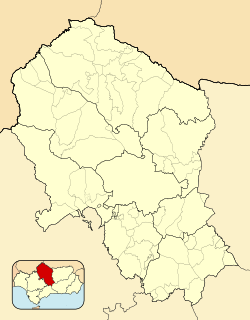Fuente Palmera
Fuente Palmera | |
|---|---|
city | |
 Church and Town Hall | |
| Coordinates: 37°42′12″N 5°06′15″W / 37.703235°N 5.104126°W | |
| Country | |
| Autonomous community | |
| Province | Córdoba |
| Comarca | Valle Medio del Guadalquivir |
| Municipality | Fuente Palmera |
| Area | |
• Total | 76 km2 (29 sq mi) |
| Elevation | 158 m (518 ft) |
| Population (2018)[1] | |
• Total | 10,817 |
| • Density | 140/km2 (370/sq mi) |
| Time zone | UTC+1 (CET) |
| • Summer (DST) | UTC+2 (CEST) |
| Website | www.fuentepalmera.es |
Fuente Palmera is a Spanish municipality in the province of Córdoba, Andalusia. Much of its territory, the district of El Villar, forms an enclave surrounded by land from the province of Seville. Currently it is known for having a large industry and for its trade, dedicated to the activity of wedding dresses.
Toponymy
[edit]It is understood that the term Fuente Palmera comes from the historical fountain next to which the population center was founded and from the presence of wild palm groves in the area. It should not be confused, in this case, and for the formation of the name, palm tree with palmetto (Chamaerops humilis).[2]
Historical documents, such as the Ensenada Cadastre, attest to the existence of the toponym before the colonization of Carlos III.[3]
Geography
[edit]Its location is within the Middle Guadalquivir Valley, and specifically in the so-called La Parrilla Desert, an area with a desert tendency but rich in irrigated crops, very close to the Guadalquivir and Genil rivers.
Climate
[edit]Fuente Palmera has a mediterranean climate (Csa) on the Köppen climate classification, with very hot, dry summers and mild, moderately wet winters. Due to its location in the Guadalquivir valley, its summers are one of the hottest in Europe and temperatures exceed 40 °C (104 °F) every year.[4]
| Climate data for Fuente Palmera (2010-2023), extremes (2010-present) | |||||||||||||
|---|---|---|---|---|---|---|---|---|---|---|---|---|---|
| Month | Jan | Feb | Mar | Apr | May | Jun | Jul | Aug | Sep | Oct | Nov | Dec | Year |
| Record high °C (°F) | 24.1 (75.4) |
24.7 (76.5) |
32.4 (90.3) |
38.5 (101.3) |
40.5 (104.9) |
43.1 (109.6) |
45.4 (113.7) |
46.4 (115.5) |
44.1 (111.4) |
37.3 (99.1) |
27.9 (82.2) |
22.9 (73.2) |
46.4 (115.5) |
| Mean daily maximum °C (°F) | 15.2 (59.4) |
17.2 (63.0) |
20.1 (68.2) |
23.4 (74.1) |
28.2 (82.8) |
33.1 (91.6) |
37.3 (99.1) |
37.3 (99.1) |
31.8 (89.2) |
26.8 (80.2) |
19.1 (66.4) |
16.1 (61.0) |
25.5 (77.8) |
| Daily mean °C (°F) | 10.0 (50.0) |
11.4 (52.5) |
14.0 (57.2) |
17.2 (63.0) |
21.2 (70.2) |
25.4 (77.7) |
28.8 (83.8) |
29.0 (84.2) |
24.9 (76.8) |
20.5 (68.9) |
14.1 (57.4) |
11.2 (52.2) |
19.0 (66.2) |
| Mean daily minimum °C (°F) | 4.8 (40.6) |
5.6 (42.1) |
8.0 (46.4) |
11.0 (51.8) |
14.1 (57.4) |
17.7 (63.9) |
20.3 (68.5) |
20.7 (69.3) |
17.9 (64.2) |
14.1 (57.4) |
9.2 (48.6) |
6.3 (43.3) |
12.5 (54.5) |
| Record low °C (°F) | −3.0 (26.6) |
−3.2 (26.2) |
−1.7 (28.9) |
3.9 (39.0) |
5.7 (42.3) |
10.5 (50.9) |
15.3 (59.5) |
15.8 (60.4) |
11.5 (52.7) |
5.9 (42.6) |
1.5 (34.7) |
−1.2 (29.8) |
−3.2 (26.2) |
| Average precipitation mm (inches) | 42.4 (1.67) |
48.3 (1.90) |
71.3 (2.81) |
60.8 (2.39) |
29.1 (1.15) |
9.0 (0.35) |
0.1 (0.00) |
12.3 (0.48) |
26.5 (1.04) |
71.4 (2.81) |
89.6 (3.53) |
75.7 (2.98) |
536.5 (21.11) |
| Source: Agencia Estatal de Meteorologia (AEMET OpenData)[5] | |||||||||||||
References
[edit]- ^ Municipal Register of Spain 2018. National Statistics Institute.
- ^ The publication Atlante Español by the Valencian Bernardo Espinalt from 1987 can serve to clear up doubts: "King Don Carlos III (may God preserve) was the founder of this town in the year 1768, and having found a copious fountain or spring in the middle of good water, in the middle of a palm grove of wild palms, the kind that make brooms and mats, was the reason they called it Fuente Palmera.
- ^ Cadastration of area 1755. Municipal Archive of Écija. Book 1140, folios 8661 and 8662. "Valdío de Fuente Palmera...". -- Rafael Vázquez Lesmes. Preconditions in the colonization of the New Towns: "...in the paguillo de los Arahales; distant from the city two and a half leagues. It borders on the east with the road to Las Pasadas (Posadas); on the west with the farmhouse of Las Guzmanas; to the north with the term of Hornachuelos that they call Picacho; and to the south with the valley that they call Cañada del Rabadán. It is made up of one thousand bushels of land, namely: Fifty bushels of dry land, planted with. medium quality. And the remaining nine hundred and fifty bushels, of mountainous land of inferior quality that only produces common grasses...
- ^ "Why is the Guadalquivir Valley one of the hottest inhabited places on earth?" (in Spanish). eldiario.es. Retrieved 29 October 2024.
- ^ "AEMET OpeenData". Agencia Estatal de Meteorologia. Archived from the original on 16 May 2024. Retrieved 12 May 2024.
External links
[edit]- Fuente Palmera – Sistema de Información Multiterritorial de Andalucía





